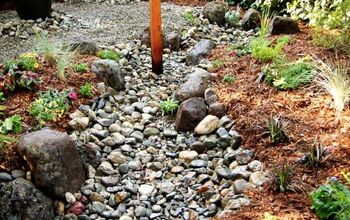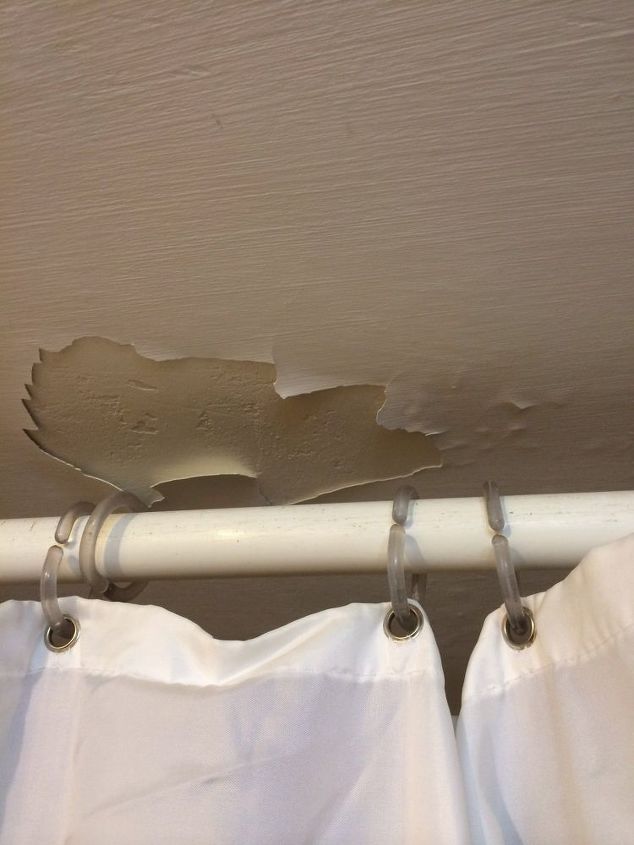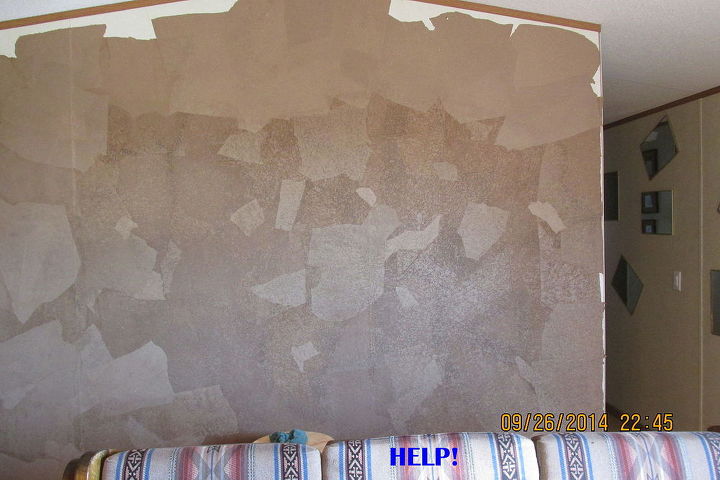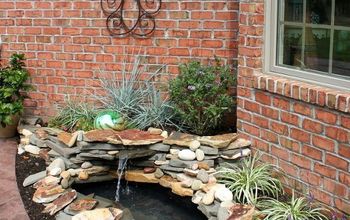Water leaks in garage and dining room area

-
My neighbor had this problem...they had a "French Drain" professionally installed. Here's a DIY link: http://www.hgtv.com/remodel/outdoors/how-to-install-french-drains
 Maggie
on Jul 11, 2016
Helpful Reply
Maggie
on Jul 11, 2016
Helpful Reply -
-
statebystategardening.com. How to build a dry river bed. Install gutters with long downspouts to direct water away from home. The downspouts terminate in the dry river bed. The dry river beds are decorative as well as functional.
 Jhunt10
on Jul 12, 2016
Jhunt10
on Jul 12, 2016
 Helpful Reply
Helpful Reply -
-
Great answers above! The first thing you have to do is find out what your problem is. Do you have adequate slope away from the house? Drive a few wooden stakes in the ground around the house and then one 3-4 feet out from the house. Then tie a string on the stake near the house out to the one away from the house. Use a level to get the string level. You will want the ground closer to the string near the house...this means that there is a slight slope away from the house. As sandy as the soil is in Florida, it should not be too difficult to slightly slope away from the house. The next thing you want to do is make sure you have adequate gutters...in size and arrangement. Make sure they are not clogged. Put extenders on he drains and run them out to a French drain or dry riverbed. Just make sure you go down deep enough for it to take care of the water. You can dig down 12-18" and put in rock, leaving the top 2" without rock and put in some dirt and then sod. If you have only a certain area, you can landscape it with plants, rocks, yard ornaments, etc, to make it attractive.
 Jeanette S
on Jul 12, 2016
Helpful Reply
Jeanette S
on Jul 12, 2016
Helpful Reply -
-
Welcome to the land that was formerly a sea bed! Jeanette is correct about checking the slope. I wish you had learned of this condition in a pre-sale home inspection. I had to remove the grass on one side of my house to dig a ditch--well create a swale to eliminate the swimming pool that formed with each rain. From an almost-native, I hope you have termite protection. The additional purpose of drains at least 18 inches away from the foundation is to reduce the moisture that termites need. And yes, they attack and damage the wood inside of concrete slab, concrete block homes.
 Anna M.S.
on Jul 12, 2016
Helpful Reply
Anna M.S.
on Jul 12, 2016
Helpful Reply -
-
I had water leaks in my 1937 basement for five years. Our basement walls always seemed to have mildew growing on them. We had very little money and even less know how. My husband's father who was born in Italy and used to repair churches as a young man in Italy. He provided us with a solution. We dug a 12 inch deep and 12 inch wide trench close to the house. We filled the trench with small stone pea gravel. This next step is important. We applied the old clay soil against the house but slanting it downward away from the house and toward our neighbor's driveway. Our house was built in 1937 but our neighbor's house was built in 1952. When they built our neighbor's home they built it somewhat higher than ours. That instigated our major leakage problem. We planted hostas all along the trench next to the house so that the dirt could not and would not wash away. We have not had a single leak in the basement for over 20 years. We painted the basement concrete block walls with DRY-Lock paint after washing them with bleach. My basement still looks great 20 years later. I realize that your home is built on a sand base but it's worth a try to dig that trench and fill it with pea gravel. It's hard work but we only had to do it ONCE. Don't plant any foundation plants that need lots of water and wait six months before planting anything at all. That's what we did. We waited until our rainy season was over to make sure the basement didn't leak. I am sure that engineers and others have better and more expensive solutions. But as my father-in-law said, "In Italy, We had no money and no engineers before the war so we used our backs, shovels and rocks to stop leaks." God bless him. He taught me how to repair almost anything.
 Nancy
on Jul 12, 2016
Nancy
on Jul 12, 2016
 Helpful Reply
Helpful Reply -
-
Many states have required disclosures for sellers in real estate transactions. You should check with your realtor as if there is a water leakage issue which obviously occurred before the sale, it should have been taken care of before the purchase. F you had the home inspected and your inspector brought this to your attention, and you knew about it in advance, I'd say you should contact a lumping contractor to help install a permanent solution rather than rely on DIY. Water damage is nothing to mess around with
 MN Mom
on Jul 12, 2016
Helpful Reply
MN Mom
on Jul 12, 2016
Helpful Reply -
-
Good gutters & downspouts...leader extensions sloping away from house toward/to a relatively deep drywell loaded with gravel.
 UpState
on Jul 12, 2016
Helpful Reply
UpState
on Jul 12, 2016
Helpful Reply -
-
Our house was built on a slope with one side going higher than the slab. This was our side entry. We had a friend use his tractor/blade to cut 2 swales leading away on either side of the door to route water to the front and back of the house. This has been working for over 35 years. No water inside since he cut those in. We did put gutters up and downspouts that flow into the swales which are basically very wide shallow ditches that are lower than the slab at the door.
 Crystal Meyer Griffith
on Jul 12, 2016
Helpful Reply
Crystal Meyer Griffith
on Jul 12, 2016
Helpful Reply -
-
Thank you for your response.
 Aggie Joseph
on Jul 12, 2016
Helpful Reply
Aggie Joseph
on Jul 12, 2016
Helpful Reply -
-
Thank you Jeanette, I appreciate your help.
 Aggie Joseph
on Jul 12, 2016
Helpful Reply
Aggie Joseph
on Jul 12, 2016
Helpful Reply -
-
I agree with MN Mom, that MUST BE DISCLOSED, PERIOD !!!!! If you want to repair yourself, install French Drains around the home. Very cheap, just a lot of labor and guaranteed to work.
 Lori
on Jul 12, 2016
Helpful Reply
Lori
on Jul 12, 2016
Helpful Reply -
-
Perforated footing drain pipes set in trenches along the foundation catch the water and drain it away from the house. Ask at Lowe's or Home Depot for the piping and instructions for installing. A task, but it does the job. Any drainage problems should have been disclosed...you may have recourse against the seller, but don't wait, there's a statute of limitations for complaints. Good luck, hope this helps.
 JoLeen Bolton
on Jul 12, 2016
Helpful Reply
JoLeen Bolton
on Jul 12, 2016
Helpful Reply -
-
Are you having a water intrusion problem? maybe provide pic of what you are describing
 Charles Prock
on Jul 13, 2016
Helpful Reply
Charles Prock
on Jul 13, 2016
Helpful Reply -
-
Florida person. Disclosure is not going to fix the problem now. I just purchased a home and have the same problem. Both sides of the garage door had puddles of water after a rain. We just fixed one side by drying it out to expose where the leak begins. One side was the downspout pouring so much water into the area that with a slope towards the garage, there was no other avenue for the water to run. An extension and some very ugly duct tape fixed that standing water after a rain. Had to wait for more rain to discover why the other side of the entry to the garage had standing water after rain. Looking at the garage door seal nothing was revealed, but watching the water flow in exposed the fact that there is a slope for about 4 ft on that side of the garage floor. It is not noticeable by the eye but with a level we can see exactly the problem. It is that the rubber seal on the bottom of the garage door does not "seal" to the cement when closed in that area due to a slight shifting of the cement garage floor, it is millimetres but enough for water to slowing work it's way under the door on that side and flow to "that" corner of the garage. That slope begins where there is a small crack in the cement. So we have a settlement issue. It takes some watching and catching the rain in action to solve some of these very disturbing issues....Had home inspection, but there is rarely rain exactly when we need it...The home inspection would not see this unless it was raining. We still have a standing water issue where our air conditioner is....Seems to me that "that"should have been a noted issue during inspection.
 Marlene
on Jul 13, 2016
Helpful Reply
Marlene
on Jul 13, 2016
Helpful Reply- See 1 previous
-
-
Hi, I'm in Florida and had similar problem with sloping yard causing rain to runoff into my enclosed porch. The French drain worked for me as well and it was a bit of work but I was lucky to have a Son with heavy equipment who dug the trench for me and hauled the pea gravel but it worked like a charm for years :-)
 Candy Williams Homan
on Jul 13, 2016
Helpful Reply
Candy Williams Homan
on Jul 13, 2016
Helpful Reply -
-
That is true Kathy in a perfect world. The only way you can prove lack of disclosure after the same is lawyer up...
 Marlene
on Jul 13, 2016
Helpful Reply
Marlene
on Jul 13, 2016
Helpful Reply -
-
When you say block house do you mean cement block? I had one once. It is a porous material so when it rains or if sprinklers hit the side of the house it filters inside. I ended up covering the exterior walls with stucco. Stucco has a plastic component that waterproofs. Never had another leak.
 Anna
on Jul 17, 2016
Helpful Reply
Anna
on Jul 17, 2016
Helpful Reply -
Related Discussions
How to get rid of mice?
We seem to have some unwelcome Mickeys and Minnies in our house. What is the best way to get rid of them?
How to remove popcorn ceiling with asbestos?
I want to remove my popcorn ceiling, but it has asbestos in it. How do I go about this safely?
How to caulk baseboard gaps?
How do I fill gaps at baseboard, should I caulk? If so, does anyone know how to caulk baseboards?
How to fix squeaky hardwood floors?
How do I fix squeaky hardwood floors?
Water damage on bathroom ceiling
I am about to patch up this water damage on a low bathroom ceiling. What can i paint/seal the entire ceiling with to minimize future water damage? the ceiling is very... See more
Brown paper floor/wall help
I have purchased a brown roll of paper because I wanted a consistent "vein" look through out the walls and the brown paper bags I was getting would sometimes be "vein... See more





